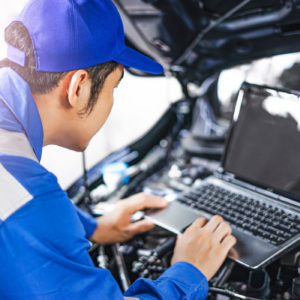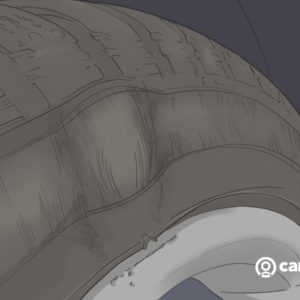The condition of your tires has an impact on the overall quality of your ride. So you must keep your tires in great shape, and that includes maintaining the recommended tire pressure.
What to Do Before Inflating Your Tires
The pressure listed on the tire itself is the maximum pressure specified by the tire manufacturer. Do not use the maximum pressure. Use the pressure shown on the decal.



One way or another, make sure to check the pressure when the tires are cold or have not been driven for a few hours. You might get an inaccurate reading if you check the pressure right after driving.
Make sure to use a good quality tire pressure gauge. And if you ever drop it, replace it. You need a reliable reading and a gauge that has been dropped can be inaccurate.
To check inflation pressure, attach the gauge to the end of your open tire valve. If you hear a hissing sound, check how the gauge is attached to the valve. The gauge shown will trap the pressure so you can read it, and the button on the side of the gauge stem releases the pressure.
How Much Air Should You Put In Your Tires?
Check your tire pressure information decal or your owner’s manual for your ride’s recommended tire pressure level. Just about all vehicles have a tire pressure information decal on their door post, although some cars may have it on the passenger side or on a rear door post.
Tires that are either over-inflated or under-inflated will wear out sooner. Over-inflated tires will wear the tread out in the center of the tire. Under-inflated tires will wear the tire out on both edges of the tire.
And you can’t just look at a tire and tell it’s low, a tire can be as much as 50% deflated and still look okay.
Tires that are either over-inflated or under-inflated will wear out sooner.
– Richard McCuistian, ASE Certified Master Automobile Technician
How to Put Air in Your Tires Using an Air Compressor
If you get a flat tire and it’s impossible to drive your car to the nearest gas station to inflate it, don’t panic. You can put air in your flat tires using an air compressor. Follow these steps to inflate your tire using an air compressor:
Take Off the Valve Stem Caps of the Tires
Set the caps somewhere secure To avoid misplacing or losing them.
Connect the Compressor to the Valve Stem
Make sure that the air hose is properly attached to the valve stem. You should hear air being transferred to your tires.
Power the Air Compressor
The engine should be on before you connect the air compressor to the car lighter socket to power it. If you’re not sure how to power your air compressor, you can refer to its manual or talk to your mechanic.

Inflate the Tires
Turn on the air compressor and wait for the gauge to reach the right psi. It might take several minutes, depending on your vehicle and tire type. Be careful not to put too much air in a tire.
Release Excess Air
If you overinflate your tires, you can release the excess by depressing the air valve. Check the tire pressure and repeat this process until you reach the desired psi.
Return the Valve Stem Caps
After inflating your tires, make sure to re-secure the caps. You can drive your vehicle but without the caps, debris and other elements could cause your tires to deteriorate faster.
If you don’t have an air compressor, there’s no shortage online and in auto parts stores, so you’ll surely find one that fits your needs.
What If My Tires Have Nitrogen Instead of Air?
If your vehicle has a green valve stem with the letter “N,” its tires are filled with nitrogen instead of air. Some gas stations have nitrogen dispensers, so you can go drive your vehicle to these places.
However, you don’t need to limit tires to nitrogen inflation. You can also fill them with normal air. But why bother with nitrogen?
Nitrogen molecules are slightly bigger than oxygen molecules. So if your tires have nitrogen, they will lose pressure more slowly. Additionally, compressed nitrogen generates less moisture than compressed air. Moisture can cause tires to expand, impairing vehicle handling.
Why Is Proper Tire Inflation Important?
If you don’t keep your tires at their correct pressure level, it can affect the following:
Fuel Economy
If your tire’s inflation drops from 30 psi to around 23 psi, it’ll affect your vehicle’s fuel efficiency. It could drop from 20 miles per gallon to 18 miles per gallon. So if you want to save money on gas, make sure that your tires are properly inflated.
Tire Lifespan
When the air pressure in your tires drops by 10 psi, its lifespan reduces by 40%. So check tire pressure regularly. Even the highest quality tires wear out faster when they’re often underinflated.
Ride Comfort and Safety
If your tires are flat or underinflated, more surface area will come into contact with the road, resulting in excessive friction. Your ride will become bumpier, and you will have problems with traction and stopping distance.
A flat tire is also more likely to wear out. This can cause a tire blowout, which can lead to an accident on the road.
What Are Tire Pressure Monitoring Systems?
The United States made tire pressure monitoring systems (TPMS) mandatory in the early 2000s due to numerous vehicle rollovers and tire blowouts because of insufficient tire pressure. All 2004 model year and later vehicles sold in the U.S. are required to have some kind of TPMS system. The TPMS system has sensors that detect if one or several of your tires have low pressure. It triggers the TPMS warning light on the dashboard when the tires are 25% underinflated.

If your tires have been rotated and the tire sensor positions weren’t re-taught, the pressures you see on each respective wheel might not be the actual pressure on the tire at that corner of the vehicle. If you’re airing up your tires, pay attention to the TPMS display to make sure the sensor is reporting the pressure of the proper tire.
But should you rely on the TPMS alone? Whether or not your vehicle has a TPMS or not, it pays to have a high-quality tire pressure gauge in your roadside kit.
How Often Should You Check Tire Pressure?
It’s best to check tire pressure at least once a month. Inflation pressure can go up and down depending on the temperature in your area, so you’ll have to adjust tire pressure accordingly. Tire quality is also a factor, as is whether or not the vehicle is garaged.
Any information provided on this Website is for informational purposes only and is not intended to replace consultation with a professional mechanic. The accuracy and timeliness of the information may change from the time of publication.






























